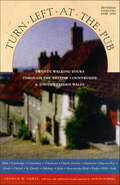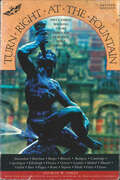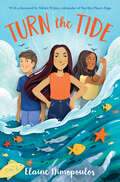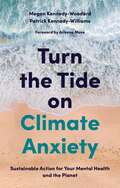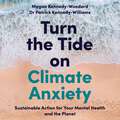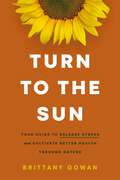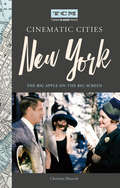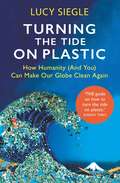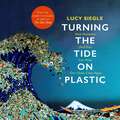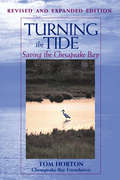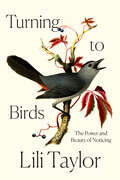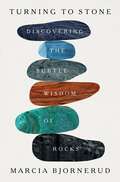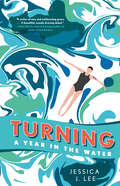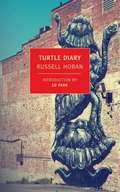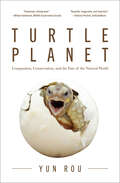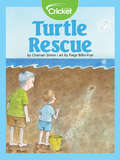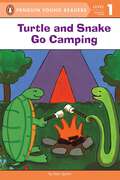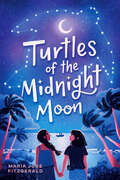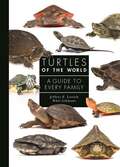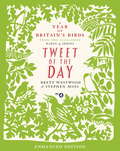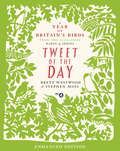- Table View
- List View
Turn Left at Orion
by Guy Consolmagno Dan M. DavisA superb guidebook described in Bookwatch as 'the home astronomer's "bible"', Turn Left at Orion provides all the information beginning amateur astronomers need to observe the Moon, the planets and a whole host of celestial objects. Large format diagrams show these objects exactly as they appear in a small telescope and for each object there is information on the current state of our astronomical knowledge. Revised and updated, this new edition contains a chapter with ten new spreads describing spectacular deep sky objects visible from the southern hemisphere, and tips on observing the upcoming transits of Venus. It also discusses Dobsonian telescopes, with hints on using personal computers and the Internet as aids for planning an observing session. Also new to this edition are redrawn "Guidepost" figures at the beginning of each season chapter that allow readers to visualize a three-dimensional view of the sky's dome; redesigned seasonal object layouts that provide more space for the naked-eye charts; a new spread on double stars near Bo_tes has been added to Spring, replacing the "Shrinking Double" spread; and a unique "When and Where to Look" table has been added to the last page, among other new features. Unlike many guides to the night sky, this book is specifically written for observers using small telescopes. Clear and easy to use, this fascinating book will appeal to skywatchers of all ages and backgrounds. No previous knowledge of astronomy is needed.
Turn Left at the Pub: Twenty Walking Tours Through the British Countryside & Southwestern Wales
by Anton Powell George W. OakesTurn Left at the Pub was first published in 1969 as a follow-up to the highly successful Turn Right at the Fountain by the same author, George Oakes. This fully updated edition features a wealth of brand new material by Anton Powell, author of Londonwalks, and takes the reader on leisurely yet educational strolls through some of the best town and country scenery that Britain has to offer. Oxford, Cambridge, and York are included, along with some lovely out of-the-way places such as Tenby, the Cornish fishing village of Solva, and St. David's, a bishop's fortified village, rich in history. Architectural and cultural details that might ordinarily be missed by a visitor are expertly noted here. True to the title, each section also features suggestions on the best pub or restaurant in which to refresh yourself at journey's .
Turn Right at the Fountain: Fifty-Three Walking Tours Through Europe's Most Enchanting Cities
by George W. Oakes Alexandra ChapmanOriginally published in 1961 and written by George W. Oakes, chief travel writer for the New York Times, this beloved walking guide has sold more than 100,000 copies in several editions. Now completely revised and updated by Alexandra Chapman, this latest edition features intimate walks through twenty-one of Europe's most celebrated cities, including an all-new chapter on Budapest, the Paris of the Danube. With this book as a guide, stroll through the winding cobblestone streets of Florence, gaze at the breath-takingly beautiful lawns of Cambridge, and explore the dark mysteries of Prague's architectural gems.Each walk is comfortably planned to take no more than a leisurely morning or afternoon, highlighting the not-to-be-missed museums, churches, and monuments as well as less conspicuous but equally charming sites. These tours offer explicit directions keyed to thirty-two easy-to-follow maps, concise descriptions of sights along the routes, and brief historical notes about buildings and other places of interest. From Amsterdam to Segovia, these expertly designed walking tours unveil the immense cultural treasures that these magical cities hold-treasures best enjoyed on foot.
Turn the Tide
by Elaine DimopoulosTwelve-year-old Mimi Laskaris is inspired by the Wijsen sisters of Bali to turn her focus from classical piano to a new obsession: forming a grassroots, kid-led movement to ban plastic bags in her new island home in Florida. Written in accessible verse, this timely story of environmental activism has extensive back matter for aspiring activists. With a foreword by Melati Wijsen, cofounder of Bye, Bye Plastic Bags.Mimi has a plan for her seventh grade year: play piano in the Young Artists competition at Carnegie Hall with her best friend, Lee; enjoy a good old Massachusetts snow day or two; and work in her community garden plot with her dad. But all that changes when her family’s Greek restaurant falls on hard times.The Laskarises’ relocation to Wilford Island, Florida, is a big key change for Mimi. Where does she fit in in this shell-covered paradise without Lee? Mimi is taken by the beauty of the island and alarmed by the plastic pollution she sees on the beaches.Then her science teacher, Ms. Miller, shows her class a TED Talk by Melati and Isabel Wijsen. At ages twelve and ten, they lobbied to ban single-use plastic bags on their home island of Bali—and won. Their story strikes a chord for Mimi. She’s twelve.Could a kid like her make such a big change in a place that she’s not yet sure feels like home? Can she manage to keep up with piano, her schoolwork, and activism? And does confident and flawless Carmen Alvarez-Hill really want to help her with the movement?In this story of environmental activism, friendship, and self-discovery, Mimi figures out what’s truly important to her, and takes her place in the ranks of real-life youth activists like the Wijsen sisters, Greta Thunberg, and Isra Hirsi.
Turn the Tide on Climate Anxiety: Sustainable Action for Your Mental Health and the Planet
by Megan Kennedy-Woodard Dr. Patrick Kennedy-WilliamsIt's hard to watch the news, scroll through social media, or listen to the radio without hearing or seeing something disturbing about the climate emergency. This can trigger all sorts of emotions: worry, anger, sadness, guilt, and even grief but also often over-looked positive emotions like motivation, connection, care, and abundance that support mental health and climate action for sustainable longevity.Written by psychologists with extensive experience in treating people with eco-anxiety, this book shows you how to harness these emotions, validate them, and transform them into positive action. It enables you to assess and understand your psychological responses to the climate crisis and move away from unhealthy defence mechanisms, such as denial and avoidance.Ultimately, it shows that the solution to both climate anxiety and the climate crisis is the same - action that is sustainable for you and for the planet - and empowers you to take steps towards this.
Turn the Tide on Climate Anxiety: Sustainable Action for Your Mental Health and the Planet
by Megan Kennedy-Woodard Dr. Patrick Kennedy-WilliamsHow to understand and manage your psychological responses to climate change to protect your mental health (and the planet).It's hard to watch the news, scroll through social media, or listen to the radio without hearing or seeing something disturbing about the climate emergency. This can trigger all sorts of emotions: worry, anger, sadness, guilt, and even grief but also often over-looked positive emotions like motivation, connection, care, and abundance that support mental health and climate action for sustainable longevity.Written by psychologists with extensive experience in treating people with eco-anxiety, this audiobook shows you how to harness these emotions, validate them, and transform them into positive action. It enables you to assess and understand your psychological responses to the climate crisis and move away from unhealthy defence mechanisms, such as denial and avoidance.Ultimately, it shows that the solution to both climate anxiety and the climate crisis is the same - action that is sustainable for you and for the planet - and empowers you to take steps towards this.(P) 2022 Jessica Kingsley Publishers
Turn to the Sun: Your Guide to Release Stress and Cultivate Better Health Through Nature
by Brittany GowanTurn to the Sun guides you down a nourishing path of uplifting affirmations, soul-refreshing meditations, and lush botanical photography that helps you heal in the company of nature. Approach your days with less anxiety, renewed vigor, and a deeper sense of well-being as you become grounded and soak up nature's restorative qualities.Whether you live in an urban jungle, on a suburban cul-de-sac, or at the edge of a national forest, you might find yourself more connected to technology than to nature. In the midst of the pings and rings of a device-dependent life, is getting close to nature even possible—or worth it?Wellness coach and the founder of Pause with Plants Brittany Gowan shows you how slowing down, unplugging, and connecting with the natural world is not only possible and absolutely worth it, but also essential. Brittany creates a reflective experience enhanced by plants that helps you find the calm and tranquility you crave.In these gorgeous, photo-filled pages, you'll find ways to:Cultivate mindfulness as you let go of daily distractionsLet nature guide you into relishing the present momentUse a nature-focused mindset to persist through challengesConnect and ground yourself with nature anywhere, anytimeNourish your relationship with yourself and the world around you Turn to the Sun includes:Affirmations: simple statements that have a positive effect on your thoughts and actionsMeditations: guidance for reflection and contemplation to center your mind and bodyHow-tos: doable exercises to fully engage with the natural worldStunning botanical photography: lush images of plants that pair with affirmations, meditations, and how-tos When in your life have you felt most alive? You can feel that way again. You can flourish, with purpose, whether you are in a waiting season or ready to blossom. It's time to pause. It's time to breathe. It's time to grow.
Turner Classic Movies Cinematic Cities: The Big Apple on the Big Screen (Turner Classic Movies)
by Christian BlauveltFor armchair travelers, film buffs, tourists, and city dwellers alike, Turner Classic Movies takes you on a one-of-a-kind tour of the cinematic sites of New York City.Highlighting the great films set in the Big Apple since the dawn of cinema to the present, Cinematic Cities: New York City is both a trove of information including behind-the-scenes stories and trivia, and a practical guide full of tips on where to go, eat, drink, shop, and sleep to follow along the path of your favorite films set in NYC. Organized by neighborhood and featuring photographs and illustrated maps throughout, this is a love letter to the city and a one-of-a-kind history of the movies.Featured films and locations include The Godfather, The Seven Year Itch, King Kong, North by Northwest, On the Town, West Side Story, When Harry Met Sally, the films of Woody Allen, and scores of others.
Turning for Home
by Mike GaddisThere is a juncture in every journey when your heart must find soon again something long, dear, and gently known.There is a waver in the wildest of wanderlust when the soul runs dry and must come again to the thing, the place, or the somebody that can make it replete.There is to every life an awakening that the miles ahead are greatly less than the ones behind, that beyond all things lies an end-that you must come again as closely as you can to where you begin.Turning for "home" . . .It is not always back to where you departed. It is not always from the place you have been. It is as much of the mind as of the matter-as much a coming, oftentimes, as a going.Sometimes the voyage is easy; sometimes the passage is steep.When we follow the ache of our souls, we discover that our emotions have been buried in many places, and that easily the most painful of these are those to which we can never return at all.Here, in a new and eclectic compilation of masterful stories and essays, one of the most revered sporting authors of our time contemplates the homecomings of the sportsman's heart. He unearths a treasury of broadly divergent encounters, from the delightfully absurd hilarity of "Love Gloves," to the piercingly intense melancholy of "A Prayer from Dark Timber." Each is told with an insight and dexterity that rarely gains expression, and each is drawn from the timeless and beloved pathways of the sporting life that wander between a laugh and a tear.
Turning the Tide on Plastic: How Humanity (And You) Can Make Our Globe Clean Again
by Lucy SiegleEnough plastic is thrown away every year to circle the world 4 times More than 8 million tonnes of plastic enter the oceans each year 300 million tonnes of new plastic is produced every year An estimated 15-51 trillion pieces of plastic now litter the world's oceans 38.5 million plastic bottles are used every day in the UK A million plastic bottles are used per minute around the world 500 million plastic straws are used per year Without big action, at the current rate, pieces of plastic will outnumber fish in the ocean by 2050. That is the legacy we are leaving our children and grandchildren. Plastic flows into our lives from every direction and most of it is not recycled. Instead it is incinerated or ends up in landfill, where it will sit for hundreds of years, or enters the world's seas where it fragments into tiny pieces to become microplastics - the environmental scourge of our times. Many of us had assumed that governments, brands and waste authorities were dealing with plastic on our behalf. But the impact of shows such as Blue Planet along with national beach cleans and high-profile campaigns have resulted in a collective wake-up call. If there were plans and strategies, they have not worked as we imagined. It would be easy to feel despondent but instead we need to turn our anger and emotion into action, starting by making a big dent in our own enormous consumption. Turning the tide on Plastic is here just in time. Journalist, broadcaster and eco lifestyle expert Lucy Siegle provides a powerful call to arms to end the plastic pandemic along with the tools we need to make decisive change. It is a clear-eyed, authoritative and accessible guide to help us to take decisive and effective personal action. Because this matters. When it comes to single-use plastics, we are habitual users, reaching out for plastic water bottles, disposable coffee cups, plastic straws and carrier bags multiple times a day. If only 12 of us adopt Lucy's 'reduce, rethink, refill, refuse' approach, we could potentially ditch 3K-15K single items of plastic in a year. When we consider our power as influencers - whether at school, the hairdressers, at work or on the bus - we suddenly become part of something significant. So now is the time to speak up, take action and demand the change you want to see in the ocean, in the supermarket aisles and on the streets. It's time to turn the tide on plastic, and this book will show you how.
Turning the Tide on Plastic: How Humanity (And You) Can Make Our Globe Clean Again
by Lucy SiegleEnough plastic is thrown away every year to circle the world 4 timesMore than 8 million tonnes of plastic enter the oceans each year300 million tonnes of new plastic is produced every year An estimated 15-51 trillion pieces of plastic now litter the world's oceans 38.5 million plastic bottles are used every day in the UKA million plastic bottles are used per minute around the world500 million plastic straws are used per yearPlastic flows into our lives from every direction and most of it is not recycled. Instead it is incinerated or ends up in landfill, where it will sit for hundreds of years, or enters the world's seas where it fragments into tiny pieces to become microplastics - the environmental scourge of our times. Without big action, at the current rate, pieces of plastic will outnumber fish in the ocean by 2050. That is the legacy we are leaving our children and grandchildren.Turning the tide on Plastic is here just in time. Journalist, broadcaster and eco lifestyle expert Lucy Siegle provides a powerful call to arms to end the plastic pandemic along with the tools we need to make decisive change. It is a clear-eyed, authoritative and accessible guide to help us to take decisive and effective personal action. If only 12 of us adopt Lucy's 'reduce, rethink, refill, refuse' approach, we could potentially ditch 3K-15K single items of plastic in a year. When we consider our power as influencers - whether at school, the hairdressers, at work or on the bus - we suddenly become part of something significant. So now is the time to speak up, take action and demand the change you want to see in the ocean, in the supermarket aisles and on the streets. It's time to turn the tide on plastic, and this book will show you how.This audio edition features exclusive extra material, including:An interview with Hugo Tagholm, CEO of Surfers Against SewageAn interview with Emily Penn, Mission Director and co-founder of eXXpedition, recorded live from Hawaii ahead of eXXpedition's voyage through the Great Pacific Garbage Patch, the densest ocean plastic accumulation zone on the planet.Tips from Fiona Llewelyn, Chair of Plastic Free St.Agnes, for how your community can cut down plastic use.Written and Read by Lucy Siegle(p) Orion Publishing Group Ltd 2018
Turning the Tide: Saving the Chesapeake Bay
by Tom Horton Chesapeake Bay Foundation William Chesapeake Bay FoundationIn 1991, Island Press published Turning the Tide, a unique and accessible examination of the Chesapeake Bay ecosystem. The book took an indepth look at the Bay's vital signs to gauge the overall health of its entire ecosystem and to assess what had been done and what remained to be done to clean up the Bay. This new edition of Turning the Tide addresses new developments of the past decade and examines the factors that will have the most significant effects on the health of the Bay in the coming years.With new case studies and updated maps, charts, and graphs, the book builds on the analytical power of ten years of experience to offer a new perspective, along with clear, science-based recommendations for the future. For all those who want to know not only how much must be done to save the Bay but what they can do and how they can make a difference, Turning the Tide is an essential source of information.
Turning to Birds: The Power and Beauty of Noticing
by Lili TaylorEye-opening essays about searching for peace in the cacophony of birds and discovering a world of meaning in small moments—from award-winning actor Lili Taylor.Most people don&’t really know birds—or rather, they aren&’t aware of them. Lili Taylor used to be one of those people. She knew birds existed. She thought about them, maybe even more than the average person. But she didn&’t know them. And then something happened. During a much-needed break from her work as an actor, Lili sought silence and instead found the bustling, symphonic world of birds that had always existed around her. Since then, she has kept a keen eye pressed to her binoculars in search of vivid stories that elevate the everyday, if only one pays attention. Through a series of beautifully crafted essays, Taylor shares her intimate encounters with the birds that have captured her heart and imagination—from tracking flitting woodpeckers through oak trees to spotting majestic blue jays perched on a Manhattan fire escape; from the exhilaration of witnessing a migratory flock from the top of the Empire State Building to the quiet joy of observing a nest of hatchlings in her own backyard. Through simply paying attention to birds, Lili has been shown a parallel world that is wider and deeper, one of constant change and movement, full of life and the will to survive.Throughout Turning to Birds, Taylor encourages mindfulness, inviting readers to be present and fully engaged with the world around them. Taylor's lyrical prose and thoughtful meditations on both the art we make and the art we discover around us create a sense of intimacy and wonder, inviting readers to see the world through new eyes and to find joy in the most unexpected places.
Turning to Stone: Discovering the Subtle Wisdom of Rocks
by Marcia BjornerudEarth is vibrantly alive and full of wisdom for those who learn to listen.Earth has been reinventing itself for more than four billion years, keeping a record of its experiments in the form of rocks. Yet most of us live our lives on the planet with no idea of its extraordinary history, unable to interpret the language of the rocks that surround us. Geologist Marcia Bjornerud believes that our lives can be enriched by understanding our heritage on this old and creative planet. Contrary to their reputation, rocks have eventful lives–and they intersect with our own in surprising ways. In Turning to Stone, Bjornerud reveals how rocks are the hidden infrastructure that keep the planet functioning, from sandstone aquifers purifying the water we drink to basalt formations slowly regulating global climate. Bjornerud’s life as a geologist has coincided with an extraordinary period of discovery in the geosciences. From an insular girlhood in rural Wisconsin, she found her way to an unlikely career studying mountains in remote parts of the world and witnessed the emergence of a new understanding of the Earth as an animate system of rock, air, water and life. We are all, most fundamentally, Earthlings and we can find existential meaning and enduring wisdom in stone.
Turning: A Year in the Water
by Jessica J. LeeThrough the heat of summer to the frozen depths of winter, Lee traces her journey swimming through 52 lakes in a single year, swimming through fear and heartbreak to find her place in the worldJessica J. Lee swims through all four seasons and especially loves the winter. "I long for the ice. The sharp cut of freezing water on my feet. The immeasurable black of the lake at its coldest. Swimming then means cold, and pain, and elation." At the age of twenty-eight, Jessica, who grew up in Canada and lived in England, finds herself in Berlin. Alone. Lonely, with lowered spirits thanks to some family history and a broken heart, she is there, ostensibly, to write a thesis. And though that is what she does daily, what increasingly occupies her is swimming. So she makes a decision that she believes will win her back her confidence and independence: she will swim fifty-two of the lakes around Berlin, no matter what the weather or season. She is aware that this particular landscape is not without its own ghosts and history. This is the story of a beautiful obsession: of the thrill of a still, turquoise lake, of cracking the ice before submerging, of floating under blue skies, of tangled weeds and murkiness, of cool, fresh, spring swimming—of facing past fears of near-drowning and of breaking free. When she completes her year of swimming, Jessica finds she has new strength, and she has also found friends and has gained some understanding of how the landscape both haunts and holds us. This book is for everyone who loves swimming, who wishes they could push themselves beyond caution, who understands the deep pleasure of using the body's strength, who knows what it is to abandon all thought and float home to the surface.
Turning: A Year in the Water
by Jessica J. LeeLonglisted for the 2018 Frank Hegyi Award for Emerging Authors&“Jessica J. Lee is a writer of rare and exhilarating grace. In Turning, she sounds the depths of lakes and her own life, never flinching from darkness, surfacing to fresh understandings of her place in the welter of natural and human history. A beautiful, moody, bracing debut.&” —Kate Harris, award-winning author of Lands of Lost BordersThrough the heat of summer to the frozen depths of winter, Lee traces her journey swimming through 52 lakes in a single year, swimming through fear and heartbreak to find her place in the worldJessica J. Lee swims through all four seasons and especially loves the winter. "I long for the ice. The sharp cut of freezing water on my feet. The immeasurable black of the lake at its coldest. Swimming then means cold, and pain, and elation." At the age of twenty-eight, Jessica, who grew up in Canada and lived in England, finds herself in Berlin. Alone. Lonely, with lowered spirits thanks to some family history and a broken heart, she is there, ostensibly, to write a thesis. And though that is what she does daily, what increasingly occupies her is swimming. So she makes a decision that she believes will win her back her confidence and independence: she will swim fifty-two of the lakes around Berlin, no matter what the weather or season. She is aware that this particular landscape is not without its own ghosts and history. This is the story of a beautiful obsession: of the thrill of a still, turquoise lake, of cracking the ice before submerging, of floating under blue skies, of tangled weeds and murkiness, of cool, fresh, spring swimming—of facing past fears of near-drowning and of breaking free. When she completes her year of swimming, Jessica finds she has new strength, and she has also found friends and has gained some understanding of how the landscape both haunts and holds us. This book is for everyone who loves swimming, who wishes they could push themselves beyond caution, who understands the deep pleasure of using the body's strength, who knows what it is to abandon all thought and float home to the surface.
Turtle Diary
by Russell Hoban Ed ParkLife in a city can be atomizing, isolating. And it certainly is for William G. and Neaera H., the strangers at the center of Russell Hoban's surprisingly heartwarming novel Turtle Diary. William, a clerk at a used-book store, lives in a rooming house after a divorce that has left him without home or family. Neaera is a successful writer of children's books, who, in her own estimation, "looks like the sort of spinster who doesn't keep cats and is not a vegetarian. Looks...like a man's woman who hasn't got a man." Entirely unknown to each other, they are both drawn to the turtle tank at the London zoo with "minds full of turtle thoughts," wondering how the turtles might be freed. And then comes the day when Neaera walks into William's bookstore, and together they form an unlikely partnership to make what seemed a crazy dream become a reality.
Turtle Planet: Compassion, Conservation, and the Fate of the Natural World
by Yun Rou#1 New Release in Biology of Reptiles & Amphibians and in Taoism - Explore the Bond Between Humans and AnimalsBe a part of it-2020 is Designated “Year of the Turtle” by Zoological and Conservation Organizations.Turtle Planet is a work of philosophical fact and fiction by ordained Daoist Monk Yun Rou. This beautifully written work of thought deeply explores the bond between humans and animals?the wisdom they teach us, the wounds they can heal, and the role we play in their destruction.A Daoist focus on personal cultivation, environmental conservation, and political and social justice. Daoist Monk Yun Rou received his academic education at Yale, Cornell, and the University of California and was ordained a Daoist monk at the Chun Yang (Pure Yang) Taoist Temple in Guangzhou, China. Drawing on fifty years of loving and husbanding turtles, from the car-sized giant Leatherback turtle to the Central Asian tortoise, Monk Yun Rou sounds the alarm of what climate change, global extinction, human intervention, and environmental devastation really mean to their worlds and to ours.See the world through the eyes of turtles. Turtle Planet renders the wonders and suffering of the natural world through the eyes of eighteen exotic turtles. An informational glossary and description of each turtle at the end of the book is provided as a bonus gift to readers.If you have read and learned from books such as H is for Hawk, The Soul of an Octopus, or Ishmael; you will be moved by Turtle Planet, a must for any reader who loves nature, cherishes animals, and celebrates ideas.
Turtle Rescue
by Charnan SimonNana is a turtle trekker! She can help Stella take care of the baby sea turtle they find on the beach.
Turtle and Snake Go Camping (Penguin Young Readers, Level 1)
by Kate SpohnTurtle and Snake are going camping. Where should they put their tent? They splash through a brook, climb over some rocks, and paddle across a pond, before they find the perfect spot. But the forest is a little too scary at night. These endearing characters help beginning readers gain confidence.
Turtles of the Midnight Moon
by María José FitzgeraldWhen poachers threaten the island they love, two girls team up to save the turtles—and each other. An eco-mystery with an unforgettable friendship story at its heart from a fresh new voice in middle grade.Twelve-year-old Barana lives in a coastal village in Honduras, where she spends every spare minute visiting the sea turtles that nest on the beach.Abby is feeling adrift in sixth grade, trying to figure out who she is and where she belongs after her best friend moved away from New Jersey.When Abby&’s papi plans a work trip to Honduras, she is finally given the opportunity to see his homeland—with Barana as her tour guide. But Barana has other plans: someone has been poaching turtle eggs, and she&’s determined to catch them! Before long, Abby and Barana are both consumed by the mystery, chasing down suspects, gathering clues, and staking out the beach in the dead of night. . . . Will they find a way to stop the poachers before it&’s too late?A heart-pounding mystery with a hint of magic, María José Fitzgerald&’s debut novel explores the power of friendship, community, and compassion to unite all living creatures.
Turtles of the World: A Guide to Every Family
by Whit Gibbons Jeffrey E. LovichA lavishly illustrated guide to the world's turtles that covers every family and genusTurtles of the World reveals the extraordinary diversity of these amazing reptiles. Characterized by the bony shell that acts as a shield to protect the softer body within, turtles are survivors from the time of the dinosaurs and are even more ancient in evolutionary terms than snakes and crocodilians. Of more than 350 species known today, some are highly endangered. In this beautiful guide, turtle families, subfamilies, and genera are illustrated with hundreds of color photographs. Each genus profile includes a population distribution map, a table of information, and commentary that includes notable characteristics and discussion of related species.More than 250 beautiful color photosEach profile features a distribution map, table of information, and commentaryBroad coverage includes every family and genus
Tuzo: The Unlikely Revolutionary of Plate Tectonics
by Nick EylesTuzo is the never-before-told story of one of Canada’s most influential scientists and the discovery of plate tectonics, a pivotal development that forever altered how we think of our planet. In 1961, a Canadian geologist named John "Jock" Tuzo Wilson (1908–1993) jettisoned decades of strongly held opposition to theories of moving continents and embraced the idea that they drift across the surface of the Earth. Tuzo tells the fascinating life story of Tuzo Wilson, from his early forays as a teenaged geological assistant working on the remote Canadian Shield in the 1920s to his experiences as a civilian-soldier in the Second World War to his ultimate role as the venerated father of plate tectonics. Illuminating how science is done, this book blends Tuzo’s life story with the development of the theory of plate tectonics, showing along the way how scientific theories are debated, rejected, and accepted. Gorgeously illustrated, Tuzo will appeal to anyone interested in the natural world around them.
Tweet of the Day: A Year of Britain's Birds from the Acclaimed Radio 4 Series
by Stephen Moss Brett WestwoodImagine a jazz musician, improvising on a theme. Then imagine that he is able to play half a dozen instruments - not one after another, but almost simultaneously, switching effortlessly between instruments and musical styles with hardly a pause for breath. If you can countenance that, you are halfway towards appreciating the extraordinary song of the nightingale . . .Wherever we are, there are birds. And wherever there are birds, there is birdsong. It's always a pleasure (and a relief) to hear sounds which prove the world's still spinning: whether it's the sighing of migrating redwings on a damp October night, the twitter of swallows fresh in from South Africa in April or the call of the cuckoo in May. Based on the scripts of BBC Radio 4's beloved year-long series, and distilling two lifetimes' knowledge, insight and enthusiasm into these pages, Brett Westwood and Stephen Moss take you month by month through the year, and the changing lives of our favourite birds. From peregrines swapping sea-cliffs for skyscrapers to swifts spending almost their entire lives on the wing; from charms of goldfinches to murmurations of starlings; from ptarmigans thriving in the Highland snow to the bright green parakeets thronging London's parks; this book is packed full of extraordinary insights and memorable facts. Tweet of the Day is a book for everyone who loves Britain's birds.(Illustrations © Carry Akroyd)
Tweet of the Day: A Year of Britain's Birds from the Acclaimed Radio 4 Series
by Stephen Moss Brett WestwoodImagine a jazz musician, improvising on a theme. Then imagine that he is able to play half a dozen instruments - not one after another, but almost simultaneously, switching effortlessly between instruments and musical styles with hardly a pause for breath. If you can countenance that, you are halfway towards appreciating the extraordinary song of the nightingale . . .Wherever we are, there are birds. And wherever there are birds, there is birdsong. It's always a pleasure (and a relief) to hear sounds which prove the world's still spinning: whether it's the sighing of migrating redwings on a damp October night, the twitter of swallows fresh in from South Africa in April or the call of the cuckoo in May. Based on the scripts of BBC Radio 4's beloved year-long series, and distilling two lifetimes' knowledge, insight and enthusiasm into these pages, Brett Westwood and Stephen Moss take you month by month through the year, and the changing lives of our favourite birds. From peregrines swapping sea-cliffs for skyscrapers to swifts spending almost their entire lives on the wing; from charms of goldfinches to murmurations of starlings; from ptarmigans thriving in the Highland snow to the bright green parakeets thronging London's parks; this book is packed full of extraordinary insights and memorable facts. Tweet of the Day is a book for everyone who loves Britain's birds.(Illustrations © Carry Akroyd)

